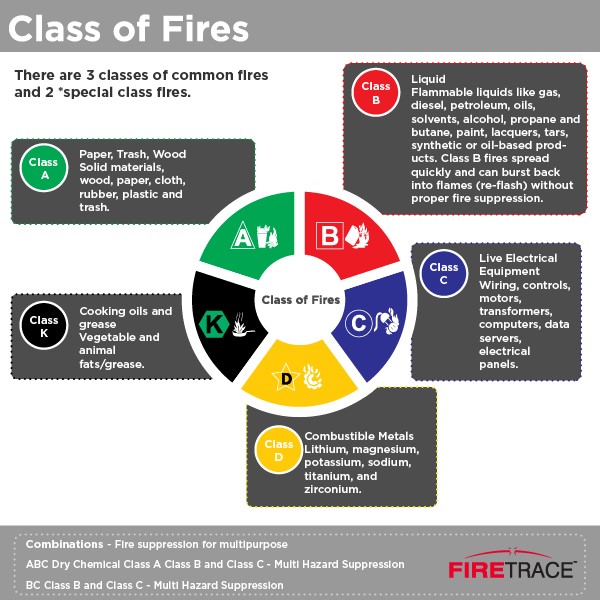Fire departments respond to more than one million fires each year in the United States alone. And while that number has been steadily decreasing since the 1970s, fires still present the potential for extremely hazardous situations whenever they occur. But while they all burn, not all fires are the same. In order to group fires—and the ways to extinguish them—fire professionals developed a system to classify fires.
So what does a fire class describe? Fire classes describe the fuel source present in addition to other common features, including how best to extinguish or suppress it. If you work in an industry with an increased risk of fire, like precision machining, it is important to understand the types of fires you might face. Read this article to learn about the different fire types and what materials are best suited to fight them.
How are Fires Organized into Classes?
Fires are grouped into classes based on the materials or substances that are present. But how many classes of fires are there? In the United States, there are five basic classes of fire, which are described below. However, it is important to note that other countries—including those in Europe as well as Australia—the names and properties of these classes differ. For example, in the United States, fire classes are named by the National Fire Protection Association (NFPA), while in Europe they are controlled by the European Standard Classification of Fires.
Understanding the type of fire present can help everyone involved know how dangerous it is and how to suppress or extinguish it.
What are the 5 Classes of Fire?
The five types of fires include: A, B, C, D, and K. Let’s explore the different types of fire, including fuel sources, dangers, and common methods used to fight them.
Class A Fire
Class A fires are the most common type of fire. They are produced from common combustible materials including wood, paper, fabric, rubber, and plastic. Class A fires have relatively low ignition temperatures, and once the fuel or oxygen has been depleted, the fire will burn out. A garbage fire is one example of Class A fires. Generally speaking, if the fire leaves ash behind, it’s likely a Class A Fire.
Water and foam agents are most often used when fighting Class A fires.
Class B Fire
Class B fires occur when flammable liquids or gases such as alcohol, kerosene, paint, gasoline, methane, oil-based coolants, or propane ignite. Class B fires are most common in industrial settings, but they may also occur in residential or commercial settings. Class B fires have a low flashpoint, which means they burn easily at any temperature if exposed to a fire source. Class B fires also spread rapidly and produce a thick black smoke as they burn.
Water is not effective when dealing with Class B fires. Instead, Carbon Dioxide (CO2) or dry chemical agents are often used to fight these fires.
Class C Fire
Class C fires are those fires that have live electrical currents or electrical equipment as a source of fuel. Such fuel sources could include electric tools, appliances, motors, and transformers. Class C fires are most common in industrial settings that deal with energy or electrically-powered equipment, like wind turbines. However, Class C fires can also occur in commercial or residential settings due to issues like faulty wiring.
Electrical fires cannot be fought with water—in fact, it can make it worse. Instead, a non-conductive chemical agent, including clean agents, should be used to put out the flames.
Class D Fire
Class D fires describe those fires that occur with a combustible metal fuel source. Common combustible metals include aluminum, lithium, magnesium, potassium, titanium, and zirconium. These types of combustible metals are most often used in laboratories and in manufacturing, so the biggest danger for Class D fires occurs in these industries.
Water can cause some combustible metals to explode, so it should not be used to fight Class D fires. Instead, dry powder agents can be used to absorb heat and smother the flames by blocking off the fire’s oxygen supply.
Class K Fire
Finally, Class K fires are cooking fires that occur as a result of the combustion of a cooking liquid like grease, oil, vegetable fat, or animal fat. Class K fires are technically a type of liquid fire, but they are separated out as their own class because of their unique setting. Class K fires are most common in the food service and restaurant industry, but can occur in any kitchen.
Like other liquid fires, water should not be sprayed onto Class K fires. Instead, wet chemical agents are the best method to use.

What is the Most Dangerous Type of Fire?
Every type of fire presents a real level of danger. Though generally speaking, fires that are likely to explode or spread quickly are often the most dangerous and can cause serious injuries in addition to property damage. That’s why understanding the types of fires and how best to extinguish or suppress them is so important.

